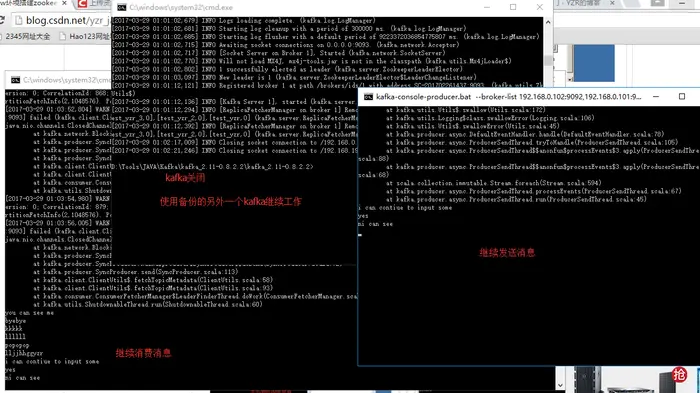本文是对在window环境下如何搭建zookeeper集群和kafka集群的研究,如果你正在查找相关此类资料,希望本文能对你有所帮助。
网上很多资料关于"kafka集群"几乎都是一个模样,写得东西很类似,而且很多细节没有注明,需要在不断的测试过程中推敲才能得到理想的结果。本篇文章力求能尽量说明每一个细节每一个步骤,达到只要认真看过本文者都能自己搭建一个基于window的kafka集群环境,当然这里仅代表学习心得,不具备任何商业用途的说明。
话不多说,实践才是硬道理。在进行搭建之前需要说明几点,为了能更好的了解本文的相关内容,推荐您先认真查阅kafka入门这篇文章,这能作为基础能让你更顺利看懂本篇文章。为了演示集群的效果,这里准备了一台虚拟机(window
server 2008),在虚拟机中搭建了单IP多节点的zookeeper集群(多IP节点的也是同理的),并且在本机(win 10)和虚拟机中都安装了kafka。简言之需要准备的东西如下:
1.三台zookeeper服务器,都安装在同一台虚拟机中。
2.本机win10,和虚拟机分别安装一台kafka服务器。
一:虚拟机和本机网络环境
1.将虚拟机的网络模式调整为桥接模式,将虚拟机的防火墙功能关闭;
2.将主机的防火墙也关闭。
3.互相ping,测试是否能正常连接.
1)查看主机或者虚拟机中的ip:
在cmd中输入ipconfig,找到IP4地址。这就是机子的ip地址。
主机win10:

虚拟机winserver2008:

2)使用ping ip地址 测试网络是否连接
在两台机子的cmd中相互输入ping一下对方的ip:
主机win10:
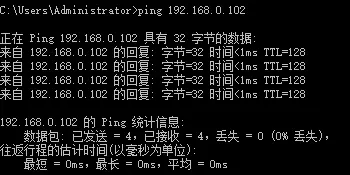
winserver2008:

二 虚拟机中搭建zookeeper集群
相对来说,zookeeper集群的搭建是很容易的,只需要注意一下配置文件。
首先准备三份zookeeper程序,这里命名为server1,server2,server3.三台zookeeper服务器不同点在于它们各自的配置文件:
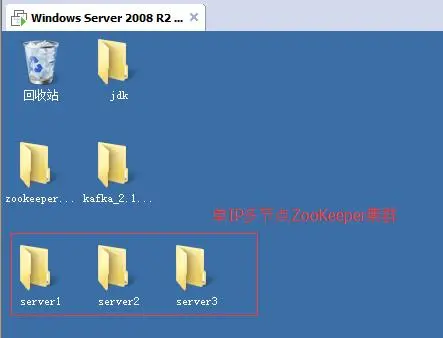
server1的zoo.cfg文件:
-
# The number of milliseconds of each tick
-
tickTime=2000
-
# The number of ticks that the initial
-
# synchronization phase can take
-
initLimit=10
-
# The number of ticks that can pass between
-
# sending a request and getting an acknowledgement
-
syncLimit=5
-
# the directory where the snapshot is stored.
-
# do not use /tmp for storage, /tmp here is just
-
# example sakes.
-
#dataDir=/tmp/zookeeper
-
dataDir=C:\\Users\\Administrator\\Desktop\\server1\\zookeeper-3.4.8\\zkdata
-
dataLogDir=C:\\Users\\Administrator\\Desktop\\server1\\zookeeper-3.4.8\\zkdatalog
-
# the port at which the clients will connect
-
clientPort=3181
-
# the maximum number of client connections.
-
# increase this if you need to handle more clients
-
#maxClientCnxns=60
-
#
-
# Be sure to read the maintenance section of the
-
# administrator guide before turning on autopurge.
-
#
-
# http://zookeeper.apache.org/doc/current/zookeeperAdmin.html#sc_maintenance
-
#
-
# The number of snapshots to retain in dataDir
-
#autopurge.snapRetainCount=3
-
# Purge task interval in hours
-
# Set to "0" to disable auto purge feature
-
#autopurge.purgeInterval=1
-
server.1=192.168.0.102:4181:5181
-
server.2=192.168.0.102:4182:5182
-
server.3=192.168.0.102:4183:5183
server2的zoo.cfg文件:
-
# The number of milliseconds of each tick
-
tickTime=2000
-
# The number of ticks that the initial
-
# synchronization phase can take
-
initLimit=10
-
# The number of ticks that can pass between
-
# sending a request and getting an acknowledgement
-
syncLimit=5
-
# the directory where the snapshot is stored.
-
# do not use /tmp for storage, /tmp here is just
-
# example sakes.
-
#dataDir=/tmp/zookeeper
-
dataDir=C:\\Users\\Administrator\\Desktop\\server2\\zookeeper-3.4.8\\zkdata
-
dataLogDir=C:\\Users\\Administrator\\Desktop\\server2\\zookeeper-3.4.8\\zkdatalog
-
# the port at which the clients will connect
-
clientPort=3182
-
# the maximum number of client connections.
-
# increase this if you need to handle more clients
-
#maxClientCnxns=60
-
#
-
# Be sure to read the maintenance section of the
-
# administrator guide before turning on autopurge.
-
#
-
# http://zookeeper.apache.org/doc/current/zookeeperAdmin.html#sc_maintenance
-
#
-
# The number of snapshots to retain in dataDir
-
#autopurge.snapRetainCount=3
-
# Purge task interval in hours
-
# Set to "0" to disable auto purge feature
-
#autopurge.purgeInterval=1
-
server.1=192.168.0.102:4181:5181
-
server.2=192.168.0.102:4182:5182
-
server.3=192.168.0.102:4183:5183
server3的zoo.cfg文件:
-
# The number of milliseconds of each tick
-
tickTime=2000
-
# The number of ticks that the initial
-
# synchronization phase can take
-
initLimit=10
-
# The number of ticks that can pass between
-
# sending a request and getting an acknowledgement
-
syncLimit=5
-
# the directory where the snapshot is stored.
-
# do not use /tmp for storage, /tmp here is just
-
# example sakes.
-
#dataDir=/tmp/zookeeper
-
dataDir=C:\\Users\\Administrator\\Desktop\\server3\\zookeeper-3.4.8\\zkdata
-
dataLogDir=C:\\Users\\Administrator\\Desktop\\server3\\zookeeper-3.4.8\\zkdatalog
-
# the port at which the clients will connect
-
clientPort=3183
-
# the maximum number of client connections.
-
# increase this if you need to handle more clients
-
#maxClientCnxns=60
-
#
-
# Be sure to read the maintenance section of the
-
# administrator guide before turning on autopurge.
-
#
-
# http://zookeeper.apache.org/doc/current/zookeeperAdmin.html#sc_maintenance
-
#
-
# The number of snapshots to retain in dataDir
-
#autopurge.snapRetainCount=3
-
# Purge task interval in hours
-
# Set to "0" to disable auto purge feature
-
#autopurge.purgeInterval=1
-
server.1=192.168.18.97:4181:5181
-
server.2=192.168.18.97:4182:5182
-
server.3=192.168.18.97:4183:5183
注意:每一个server下的zoo.cfg内容中主要关注几个点,dataDir是zookeeper存放数据的地方,自己手动新建一个位置,比如这里是zkdata,将路径赋值给dataDir即可。同理dataLogDir。对于clientPort是客户端端口,在单IP多节点的这种方式每个clientPort不能一样。在最后server.1,server.2,server.3这是指定zookeeper服务器,第一个端口比如4181是指各个zookeeper之间的通信端口,5181是各个zookeeper的选举leader端口。还有最重要的一点是这个server.1还要在zkdata文件夹下新建一个没有后缀名的myid文件,里面填写1.同理,server.2是在zkdata文件夹下新建一个myid,里面填写2.以此类推,比如server.3的话,请看下图:
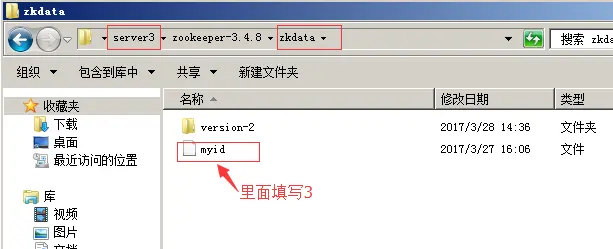
启动zookeeper集群:一个一个启动每一个zookeeper服务器:
先后进入每一个zookeeper服务器的bin目录下执行zkserver.cmd,在先启动的zookeeper会打印其他zookeeper服务器未启动的错误信息,直至到最后一个启动的时候就没有异常信息了。
启动:
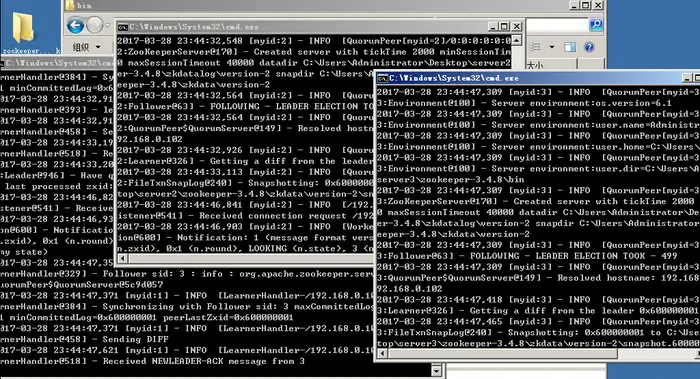
三 kafka集群
1.配置server.properties文件:
因为模板里面内容挺多的,我就贴一个出来作为演示说明:
-
# Licensed to the Apache Software Foundation (ASF) under one or more
-
# contributor license agreements. See the NOTICE file distributed with
-
# this work for additional information regarding copyright ownership.
-
# The ASF licenses this file to You under the Apache License, Version 2.0
-
# (the "License"); you may not use this file except in compliance with
-
# the License. You may obtain a copy of the License at
-
#
-
# http://www.apache.org/licenses/LICENSE-2.0
-
#
-
# Unless required by applicable law or agreed to in writing, software
-
# distributed under the License is distributed on an "AS IS" BASIS,
-
# WITHOUT WARRANTIES OR CONDITIONS OF ANY KIND, either express or implied.
-
# See the License for the specific language governing permissions and
-
# limitations under the License.
-
# see kafka.server.KafkaConfig for additional details and defaults
-
-
############################# Server Basics #############################
-
-
# The id of the broker. This must be set to a unique integer for each broker.
-
broker.id=1
-
broker.list=192.168.0.101:9093,192.168.0.102:9092
-
############################# Socket Server Settings #############################
-
-
# The port the socket server listens on
-
port=9093
-
-
# Hostname the broker will bind to. If not set, the server will bind to all interfaces
-
#host.name=localhost
-
-
# Hostname the broker will advertise to producers and consumers. If not set, it uses the
-
# value for "host.name" if configured. Otherwise, it will use the value returned from
-
# java.net.InetAddress.getCanonicalHostName().
-
#advertised.host.name=<hostname routable by clients>
-
-
# The port to publish to ZooKeeper for clients to use. If this is not set,
-
# it will publish the same port that the broker binds to.
-
#advertised.port=<port accessible by clients>
-
-
# The number of threads handling network requests
-
num.network.threads=3
-
-
# The number of threads doing disk I/O
-
num.io.threads=8
-
-
# The send buffer (SO_SNDBUF) used by the socket server
-
socket.send.buffer.bytes=102400
-
-
# The receive buffer (SO_RCVBUF) used by the socket server
-
socket.receive.buffer.bytes=102400
-
-
# The maximum size of a request that the socket server will accept (protection against OOM)
-
socket.request.max.bytes=104857600
-
-
-
############################# Log Basics #############################
-
-
# A comma seperated list of directories under which to store log files
-
#log.dirs=/tmp/kafka-logs
-
log.dirs=G:\Tools\JAVA\Kafka\kafka_2.11-0.8.2.2\kafka_2.11-0.8.2.2\kafka-logs
-
-
# The default number of log partitions per topic. More partitions allow greater
-
# parallelism for consumption, but this will also result in more files across
-
# the brokers.
-
num.partitions=3
-
-
# The number of threads per data directory to be used for log recovery at startup and flushing at shutdown.
-
# This value is recommended to be increased for installations with data dirs located in RAID array.
-
num.recovery.threads.per.data.dir=1
-
-
############################# Log Flush Policy #############################
-
-
# Messages are immediately written to the filesystem but by default we only fsync() to sync
-
# the OS cache lazily. The following configurations control the flush of data to disk.
-
# There are a few important trade-offs here:
-
# 1. Durability: Unflushed data may be lost if you are not using replication.
-
# 2. Latency: Very large flush intervals may lead to latency spikes when the flush does occur as there will be a lot of data to flush.
-
# 3. Throughput: The flush is generally the most expensive operation, and a small flush interval may lead to exceessive seeks.
-
# The settings below allow one to configure the flush policy to flush data after a period of time or
-
# every N messages (or both). This can be done globally and overridden on a per-topic basis.
-
-
# The number of messages to accept before forcing a flush of data to disk
-
#log.flush.interval.messages=10000
-
-
# The maximum amount of time a message can sit in a log before we force a flush
-
#log.flush.interval.ms=1000
-
-
############################# Log Retention Policy #############################
-
-
# The following configurations control the disposal of log segments. The policy can
-
# be set to delete segments after a period of time, or after a given size has accumulated.
-
# A segment will be deleted whenever *either* of these criteria are met. Deletion always happens
-
# from the end of the log.
-
-
# The minimum age of a log file to be eligible for deletion
-
log.retention.hours=168
-
-
# A size-based retention policy for logs. Segments are pruned from the log as long as the remaining
-
# segments don't drop below log.retention.bytes.
-
#log.retention.bytes=1073741824
-
-
# The maximum size of a log segment file. When this size is reached a new log segment will be created.
-
log.segment.bytes=1073741824
-
-
# The interval at which log segments are checked to see if they can be deleted according
-
# to the retention policies
-
log.retention.check.interval.ms=300000
-
-
# By default the log cleaner is disabled and the log retention policy will default to just delete segments after their retention expires.
-
# If log.cleaner.enable=true is set the cleaner will be enabled and individual logs can then be marked for log compaction.
-
log.cleaner.enable=false
-
-
############################# Zookeeper #############################
-
-
# Zookeeper connection string (see zookeeper docs for details).
-
# This is a comma separated host:port pairs, each corresponding to a zk
-
# server. e.g. "127.0.0.1:3000,127.0.0.1:3001,127.0.0.1:3002".
-
# You can also append an optional chroot string to the urls to specify the
-
# root directory for all kafka znodes.
-
zookeeper.connect=192.168.0.102:3181,192.168.0.102:3182,192.168.0.102:3183
-
-
# Timeout in ms for connecting to zookeeper
-
zookeeper.connection.timeout.ms=6000
需要修改的几个地方:
broker.id=1
broker.list=192.168.0.101:9093,192.168.0.102:9092
port=9093
log.dirs=G:\Tools\JAVA\Kafka\kafka_2.11-0.8.2.2\kafka_2.11-0.8.2.2\kafka-logs
zookeeper.connect=192.168.0.102:3181,192.168.0.102:3182,192.168.0.102:3183
每一个kafka服务器都需要有一个唯一的broker.id,这个broker.list是kafka集群的地址。
2.启动kafka集群,创建topics
主机win10启动kafka:

虚拟机启动kafka并且创建一个带2个备份的topic(test_yzr_2017_03_29)
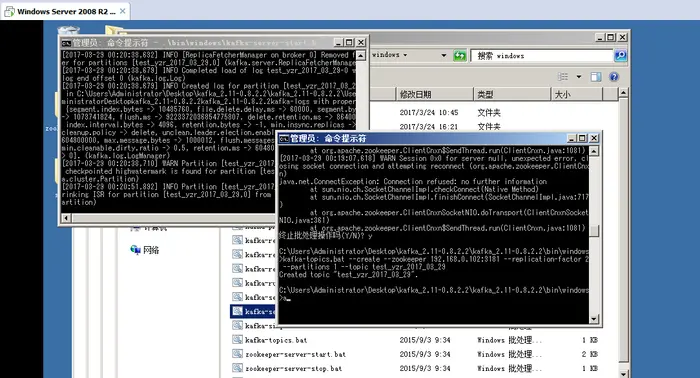
三 测试集群
1.消息提供者和消费者之间的消息流通测试
比如在虚拟机上创建一个消息提供者:
kafka-console-producer.bat --broker-list 192.168.0.102:9092,192.168.0.101:9093 --topic test_yzr_2017_03_29
在虚拟机和win10主机上都创建一个消息消费者:
kafka-console-consumer.bat --zookeeper 192.168.0.102:3181 --topic test_yzr_2017_03_29
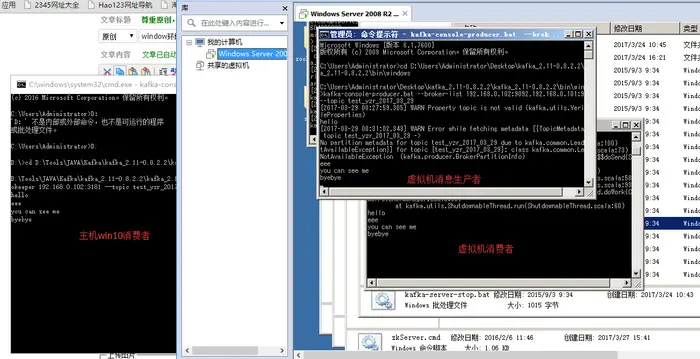
2.集群的容错性:
首先查看topic的信息
kafka-topics.bat --list --zookeeper 192.168.0.102:3181
或是改成(kafka-topics.bat --list --zookeeper 192.168.0.102:3182 和kafka-topics.bat --list --zookeeper 192.168.0.102:3183都是可以的,因为zookeeper集群共享数据)
查看指定的topic的详细信息:
kafka-topics.bat --describe --zookeeper --192.168.0.102:3181 --topic test_yzr_2017_03_29
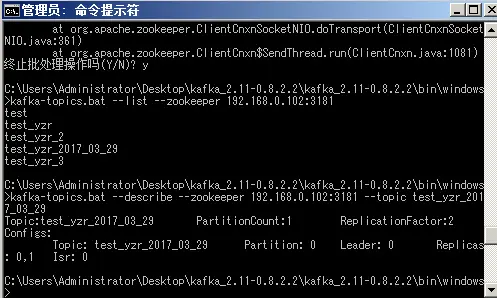
可以看到此时选举的leader是0,即就是虚拟机中的kafka服务器,现在把虚拟机的kafka服务器给干掉。
此时leader为变为1,消费者能继续消费。
